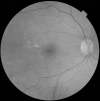The English National Screening Programme for diabetic retinopathy 2003-2016
- PMID: 28224275
- PMCID: PMC5429356
- DOI: 10.1007/s00592-017-0974-1
The English National Screening Programme for diabetic retinopathy 2003-2016
Abstract
The aim of the English NHS Diabetic Eye Screening Programme is to reduce the risk of sight loss amongst people with diabetes by the prompt identification and effective treatment if necessary of sight-threatening diabetic retinopathy, at the appropriate stage during the disease process. In order to achieve the delivery of evidence-based, population-based screening programmes, it was recognised that certain key components were required. It is necessary to identify the eligible population in order to deliver the programme to the maximum number of people with diabetes. The programme is delivered and supported by suitably trained, competent, and qualified, clinical and non-clinical staff who participate in recognised ongoing Continuous Professional Development and Quality Assurance schemes. There is an appropriate referral route for those with screen-positive disease for ophthalmology treatment and for assessment of the retinal status in those with poor-quality images. Appropriate assessment of control of their diabetes is also important in those who are screen positive. Audit and internal and external quality assurance schemes are embedded in the service. In England, two-field mydriatic digital photographic screening is offered annually to all people with diabetes aged 12 years and over. The programme commenced in 2003 and reached population coverage across the whole of England by 2008. Increasing uptake has been achieved and the current annual uptake of the programme in 2015-16 is 82.8% when 2.59 million people with diabetes were offered screening and 2.14 million were screened. The benefit of the programme is that, in England, diabetic retinopathy/maculopathy is no longer the leading cause of certifiable blindness in the working age group.
Keywords: Blindness; Diabetic retinopathy; Screening.
Conflict of interest statement
Conflict of interest
None.
Ethical standard
The author has complied with the journals ethical standards.
Statement of human and animal rights
This article does not contain any studies with human or animal subjects performed by the any of the authors.
Informed consent
All patients screened in the English Diabetic Eye Screening Programme provide informed consent to the procedure.
Figures
References
-
- Iceland (2015) http://www.idf.org/membership/eur/iceland. Accessed 03 Feb 1017
-
- Facts and Stats (2016) https://www.diabetes.org.uk/Documents/Position%20statements/DiabetesUK_F.... Accessed 03 Feb 2017
-
- Screening for diabetic retinopathy in Europe—strategies for overcoming hurdles to progress (2011) http://www.drscreening2005.org.uk/gdansk_2011.html. Accessed 03 Feb 2017
-
- Wilson J, Jungner G. The principles and practice of screening for disease. Geneva: Public Health Papers 34. Public Health Papers, WHO; 1968.
Publication types
MeSH terms
LinkOut - more resources
Full Text Sources
Other Literature Sources
Medical





